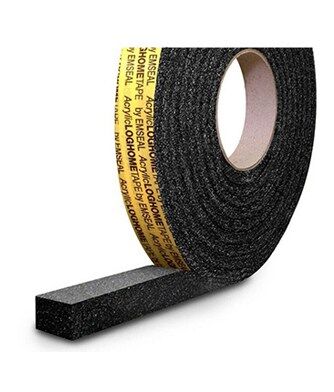Emseal Log Home Gasket Tape
$9.99 – $599.99
Emseal offers 2 Types of Log Home Gasket Tapes:
CLASSIC: For more than 30 years EMSEAL has offered an economical, expanding, open-cell, foam tape impregnated with water-based, acrylic-modified asphalt. Classic Log Home Gasket Tape provides UV stability and sealing ability, as well as resistance to aging and to vermin (bugs, rodents, birds, etc.).
ACRYLIC: EMSEAL Acrylic Log Home Gasket Tape was developed in the early 1980’s using in place of asphalt, a water-based, acrylic impregnation. Compatible with liquid sealants, chinking, and stains and preservatives, it is clean-handling and free from visible contact staining.
EMSEAL Acrylic Log Home Gasket Tape is particularly suitable for construction methods such as Swedish cope and is widely used by handcrafters. It is also suitable for flat-on-flat construction where sealant tape is installed at the outer edges of the logs AND where sprayed-on log sealer or stain may come in contact with the tape.
Emseal FAQs
WHY USE EMSEAL LOG HOME SEALANTS
EMSEAL Log Home Tapes are high performance sealants with the following characteristics:
- Permanent elasticity/memory enables it to fill gaps caused by changes in log size (shrinking and settling)
- Continuous backpressure enables the foam sealant to fill contours and irregularities
- Maintains weathertight seal and thermally insulates over extreme temperature ranges
- Does not dry out, become brittle or crack
- Unlike putty-type (butyl) and liquid sealants which squeeze-out under compression, Log Home Tape compresses into itself and remains in place between the logs where it is needed.
- Resistant to ultraviolet light and ozone
- Does not cause “log-float” (suspension of logs by air filled cells of closed-cell gaskets)
- Easy to install with mounting-adhesive on one side— strong polyester scrim embedded in adhesive resists stretching of material during installation
- Highly resistant to vermin (bugs, rodents, birds, etc.)
- No ozone-depleting chemicals used in manufacturing and contains no volatile organic compounds (V.O.C.’s)
THE EMSEAL ADVANTAGE: HOW IT WORKS
Open-cell foam is impregnated, compressed to the size of the opening to be sealed, and shipped in reels. The stored strain-energy of compression in the foam means continuous back-pressure is exerted against the logs. This pressure, combined with the adhesive nature of the impregnation, assures reliable adhesion to both upper and lower log surfaces. As the logs shrink and expand with seasonal temperature and humidity changes, long-term sealing contact with the log surfaces is maintained.
FACTORS IN COMPARING GASKETING MATERIALS:
- Backpressure – The pressure exerted by the seal against the log surfaces. This must be sufficient to cause the seal to expand as a gap opens but not so great that it causes “log float”.
- Recovery – This indicates how completely the foam recovers to its original dimension after extended compression. The higher the recovery percentage, the better the seal.
- Durability – This includes the ability to resist ultraviolet light and ozone exposure that can cause brittleness, cracking and ultimately seal failure.
- Wood-Preservative Compatibility – Some foam sealants can be applied to treated wood, others only to wood that has not been treated. The foam sealant should work with preservatives, whether applied before or after installation of the seal.
- Ease of Installation – Some foams are self-sticking, with removable release for easy installation.
AVOID COMMON MISTAKES
Sealant sizing:
Perhaps one of the most costly mistakes made in log home sealing is to undersize the preformed sealant used between horizontal log courses. The sealant should match the joint-gap size after settlement and shrinkage have been allowed for.
High performance sealant vs. low-cost short-life alternatives:
High performance sealants, properly sized and applied are the better choice. Consider the cost of routing-out and replacing old sealant against the up-front cost of a high performance sealant.
Check available sealant depth:
As the tape width is increased, so does the ultimate margin of safety. However, tape width is also determined by the tongue and groove or other configuration present. Ensure that within these parameters maximum use is made of tape width.
Correct sealant termination:
If your log home had no openings (i.e. windows or doors let into the walls), then the correct sealant configuration would be continuous seals running completely around each log course. This means that at each corner the sealant would be lapped to provide suitable horizontal seal integrity. Since openings are present in the structure for doors and windows, seal integrity must be preserved both, horizontally and vertically. Care must be taken to ensure that horizontal and vertical seals terminate into one another.
Double vs. single sealant System:
It is generally accepted that the use of a double gasket system is preferable to the use of a single gasket system. A “dead-air” void is created between the two seals which greatly enhances the thermal insulation properties of the log home.
Sealant positioning:
Good joint design provides for the seal to be positioned at a high point in the joint detail so that as much as possible, water tends to drain away from the seal area.
| Weight | 10 lbs |
|---|---|
| Dimensions | 6.75 × 6.75 × 8 in |
| Brand | Emseal |






Reviews
There are no reviews yet.